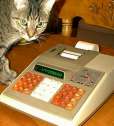Truly SC111
| Datasheet legend
Ab/c:
Fractions calculation
AC: Alternating current BaseN: Number base calculations Card: Magnetic card storage Cmem: Continuous memory Cond: Conditional execution Const: Scientific constants Cplx: Complex number arithmetic DC: Direct current Eqlib: Equation library Exp: Exponential/log functions Fin: Financial functions Grph: Graphing capability Hyp: Hyperbolic functions Ind: Indirect addressing Intg: Numerical integration Jump: Unconditional jump (GOTO) Lbl: Program labels LCD: Liquid Crystal Display LED: Light-Emitting Diode Li-ion: Li-ion rechargeable battery Lreg: Linear regression (2-var. stats) mA: Milliamperes of current Mtrx: Matrix support NiCd: Nickel-Cadmium recharg. batt. NiMH: Nickel-metal-hydrite rech. batt. Prnt: Printer RTC: Real-time clock Sdev: Standard deviation (1-var. stats) Solv: Equation solver Subr: Subroutine call capability Symb: Symbolic computing Tape: Magnetic tape storage Trig: Trigonometric functions Units: Unit conversions VAC: Volts AC VDC: Volts DC |
| ||||||||||||||||||||||||||||||||||||||||||||||||||||||||
Truly SC111
 This curious little calculator is an enigmatic machine. Its features, keyboard layout, programming model, and many of its idiosyncrasies suggest that this is just a Casio calculator in OEM disguise. But I am not aware of any Casio machine with exactly the same set of features (although the fx-50F comes pretty darn close.) Moreover, there are some intriguing differences; most notably, Mike Sebastian's forensics test produces a previously unknown result. So the question remains open: is this really a Casio, or is it a copycat model?
This curious little calculator is an enigmatic machine. Its features, keyboard layout, programming model, and many of its idiosyncrasies suggest that this is just a Casio calculator in OEM disguise. But I am not aware of any Casio machine with exactly the same set of features (although the fx-50F comes pretty darn close.) Moreover, there are some intriguing differences; most notably, Mike Sebastian's forensics test produces a previously unknown result. So the question remains open: is this really a Casio, or is it a copycat model?
The SC111 is a surprisingly pleasant and capable calculator. Inside the small, but relatively sturdy package is a machine with a comprehensive set of scientific, statistical, and binary arithmetic functions, a built-in formula library with 39 preprogrammed formulae, and even 9 physical constants, made particularly useful by keyboard labeling that indicates, in addition to the constant's name, the unit of dimensions in which the constant is represented.
Alas, the SC111 has the same amount of program memory as the most limited programmable Casio machines: a mere 29 program steps. A fully merged programming model helps, but even so, a machine this capable should have been equipped with a more generous amount of programming space.
Yet it is actually possible to write useful non-trivial programs in 29 steps. This is demonstrated by an implementation of the incomplete Gamma function shown for the Radio Shack EC-4024 (an OEM version of the Casio fx-50F). Here is another program, one which supplements Stirling's formula with a simple iteration to compute the logarithm of the Gamma function to 6-digit accuracy. Prior to using this program, you must store the value 2π in the calculator's independent memory:
01 + 02 ln 03 Kin+ 1 04 1 05 = 06 x<=M 07 + 08 x-K 1 09 - 10 Kout 1 11 × 12 ln 13 - 14 ( 15 MR 16 ÷ 17 Kout 1 18 ) 19 √ 20 ln 21 x-y 22 + 23 1 24 2 25 1/x 26 ÷ 27 0 28 x-K 1 29 =


